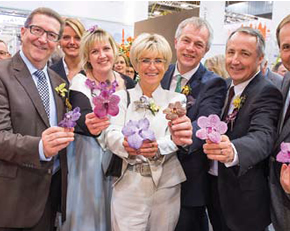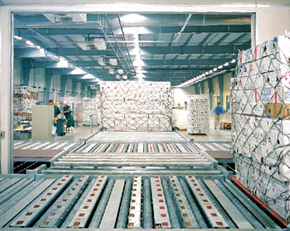Featured Past Articles
Dümmen Orange Startng Off 2016 On the Road
 Dümmen Orange is on the road again. The breeder had introduced the flower-trials-on-wheels concept in January 2015. A truck was completely restyled into a trial on wheels and visited its trade partners at the various FloraHolland auctions in The Netherlands. Exactly one year later, the cut chrysanthemums are back at their familiar spot in the truck.
Dümmen Orange is on the road again. The breeder had introduced the flower-trials-on-wheels concept in January 2015. A truck was completely restyled into a trial on wheels and visited its trade partners at the various FloraHolland auctions in The Netherlands. Exactly one year later, the cut chrysanthemums are back at their familiar spot in the truck.
Royal De Ruiter East Africa, Closing the Year on a High Note
An atmosphere of enthusiasm greets us when we arrive at the Royal De Ruiter East Africa farm in Naivasha Kenya. Our visit comes when Royal De Ruiter is just fresh from the unveiling of their new corporate identity. At a ceremony held during this year’s IFTF show in the Netherlands, the company represented by its directors Henk de Groot and Oscar Peters was presented with Royal designation by Mayor Drs. MM van ‘t Veld. The ceremony also marked Royal De Ruiter’s 100 years since establishment.
What would you attribute your success to considering you indicated the inaugural show exceeded expectations?
 The fact that Kenya is one of the countries in the world where the production area of flowers structurally increases is a strong indicator that the sector -overall- is in a good shape. Moreover, growth in a worldwide economical turmoil shows that the sector has to row against the stream and still moves forward. This cannot mean anything different than strength for even more growth when coming into calm waters. Therefore IFTEX is an excellent instrument for the Kenyan floriculture Industry to support and accelerate this growth.
The fact that Kenya is one of the countries in the world where the production area of flowers structurally increases is a strong indicator that the sector -overall- is in a good shape. Moreover, growth in a worldwide economical turmoil shows that the sector has to row against the stream and still moves forward. This cannot mean anything different than strength for even more growth when coming into calm waters. Therefore IFTEX is an excellent instrument for the Kenyan floriculture Industry to support and accelerate this growth.
What has been your most ‘unexpected’ occurrence at the show?
I was 100% confident that this trade fair could not fail and would be a “full house”. The only big unknown factor was how to convince the Kenyan growers that this would work if they just would believe in it. Never before in my career of organising flower trade expos anywhere else in the world, I had so many excellent building parts in my hand to create the almost ‘perfect’ flower trade exhibition, I am even tempted to call it. Being a flower trade expo specialist, I got very excited the moment I added it all up and suddenly visualized the ideal place for an African flower trade expo could, would and should be Kenya and Kenya only. I then decided to hold as many meetings with the growers as needed until they would be convinced to give it a try and take a booth. It was somehow still unexpected though when I finally I managed to get enough on board. The rest as they say is history. Growers from the region have also joined the show.
Read more: Perfect Conditions for Growing an International Exhibition
World’s Leading Fair for Horticulture Consolidates Its Position as the Most Important Platform in the International Green Sector Even Further
 An outstanding mood at the 34th International Plant Fair IPM ESSEN 2016. The world’s leading fair for horticulture was once more able to prove that it is the most important platform for the international green sector. From January 26 to 29, 2016, 1,588 exhibitors from 49 nations presented their innovations and new products along the value added chain in horticulture to first-rate trade visitors from all continents at Messe Essen. The comprehensive range on offer included new plant creations, pioneering technology, strong-selling floristry trends and marketing concepts oriented to target groups. The Innovation Showcase which set a record with 76 plant novelties was representative of the enormous innovative force of the sector.
An outstanding mood at the 34th International Plant Fair IPM ESSEN 2016. The world’s leading fair for horticulture was once more able to prove that it is the most important platform for the international green sector. From January 26 to 29, 2016, 1,588 exhibitors from 49 nations presented their innovations and new products along the value added chain in horticulture to first-rate trade visitors from all continents at Messe Essen. The comprehensive range on offer included new plant creations, pioneering technology, strong-selling floristry trends and marketing concepts oriented to target groups. The Innovation Showcase which set a record with 76 plant novelties was representative of the enormous innovative force of the sector.
“IPM ESSEN has once more proven that it is indisputably the most important fair for international horticulture. The innovations are introduced here and the orders for the coming season are placed here. This year, it was again possible to raise the number and quality of the visitors and the sales transactions. We are more than satisfied,” was the summary made by Oliver P. Kuhrt, CEO of Messe Essen. This year, IPM ESSEN counted 57,200 visitors (in 2015: 56,500). More than 78 percent of the visitors have decision-making or procurement powers - a plus of three percentage points in comparison with the preceding year. 36 percent of the trade public already placed orders at IPM ESSEN 2016 (in 2015: 34 percent). The visitors rated the available range as very positive. Around 93 percent passed on recommendations to visit the fair. The exhibitors also made very positive assessments: 92 percent stated that their expectations for IPM ESSEN 2016 had been met. They reported on a large number of new foreign contacts and successful deals.
Read more: More Visitors, More Decision Makers and More Business Transactions
‘Product Proof’ and the collaboration with GLOBAL G.A.P. spearhead the MPS trade fair presentation
At the IPM there is considerable interest in the Product Proof sustainability initiative, which MPS announced last week it would widely roll out in the horticultural sector in the fourth quarter. This will offer growers many advantages combined with the announced collaboration with GLOBALG.A.P.
Product Proof is a system that is able to demonstrate that certain active substances were not used in cultivation by means of compulsory daily registration and independent sampling. Tests are performed to, for example, ascertain whether an active substance was administered in accordance with the label and whether the substance is registered on a daily basis. Tests also examine whether the active substance appears on the so-called ‘bee unfriendly’ list and whether it belongs to the neonicotinoids group. A verification of the restrictions, which a specific customer has imposed, completes the process and affords Product Proof a tailor-made character. Growers that possess an MPSABC certificate are eligible for Product Proof.
Closer 240SC is powered by IsoclastTM active (sulfoxaflor), discovered by and proprietary to Dow AgroSciences, currently is the sole member of a new chemical class of insecticides, the sulfoximines in the chemical class 4C. Isoclast has been developed globally for use in major crop groups, including Roses, Carnations, Cotton, leafy and fruiting vegetables, apples, soybeans, rice (outside of the U.S.), cereals, citrus, cole crops, grapes, and other crops. Isoclast controls economically important and difficult-to control sap-feeding insect pests including most species of aphids, jassids, leafhoppers, mealybugs, plant bugs, plant hoppers, stink bugs, and whiteflies, and certain species of psyllids and scales.
 “Temperature is the single most important factor that affects flower value. Therefore, keeping flowers in low temperatures from the farm to the final destination is vital. Among the key areas of consideration is the transport from the farm to the airport. A well known and an increasingly more used tool to achieve this is the use of insulated refrigerated bodies.
“Temperature is the single most important factor that affects flower value. Therefore, keeping flowers in low temperatures from the farm to the final destination is vital. Among the key areas of consideration is the transport from the farm to the airport. A well known and an increasingly more used tool to achieve this is the use of insulated refrigerated bodies.
These systems are known to be durable and most energy efficient way to cool flowers. However, it is of utmost importance on whom and how it is incorporated in your cool chain.” This is explained by Mr. Ross G. Field of Specialized Fibreglass.
“We built our reputation and success on design excellence, quality control, and customer service. In this competitive market we have remained to be cost efficient and price competitive too, but not at the expense of quality”, says Mr. Ross Field. Therefore, using Specialized Fibreglass Ltd insulated bodies has some major advantages compared to others
The Best Postharvest of Cut Flowers
 Floriculture is an agricultural sector of worldwide importance and of paramount social and economical influence. Roses account to a large percentage of all flowers grown. After flowers are harvested, temperature is the one factor affecting them the most. This is the time to evaluate different cooling methods used in the postharvest of roses, by measuring their effects over floral longevity and other quality variables. The residual effects of passive, forced air and vacuum cooling methods were evaluated, after transport simulation. The test was performed at a flower-exporting farm. It was found that those flowers exposed to vacuum cooling showed the longest longevity while those that took forced air had the lowest.
Floriculture is an agricultural sector of worldwide importance and of paramount social and economical influence. Roses account to a large percentage of all flowers grown. After flowers are harvested, temperature is the one factor affecting them the most. This is the time to evaluate different cooling methods used in the postharvest of roses, by measuring their effects over floral longevity and other quality variables. The residual effects of passive, forced air and vacuum cooling methods were evaluated, after transport simulation. The test was performed at a flower-exporting farm. It was found that those flowers exposed to vacuum cooling showed the longest longevity while those that took forced air had the lowest.
The main cause of elimination of flowers was the presence of Botrytis (44%) and dormancy (35%). No significant differences in such causes were found among the various cooling treatments; however it was observed that those flowers that went through the passive and forced air cooling methods showed presence of Botrytis much sooner than those exposed to vacuum cooling. Furthermore bent neck in vacuum cooled flowers only were observed after day 12 while in the other treatments that happened within the first five days of the test. With regard to the quantity of stems affected by dehydration, no differences were found among all treatments, which refutes the common belief that vacuum cooling accelerates dehydration of flower stems.


